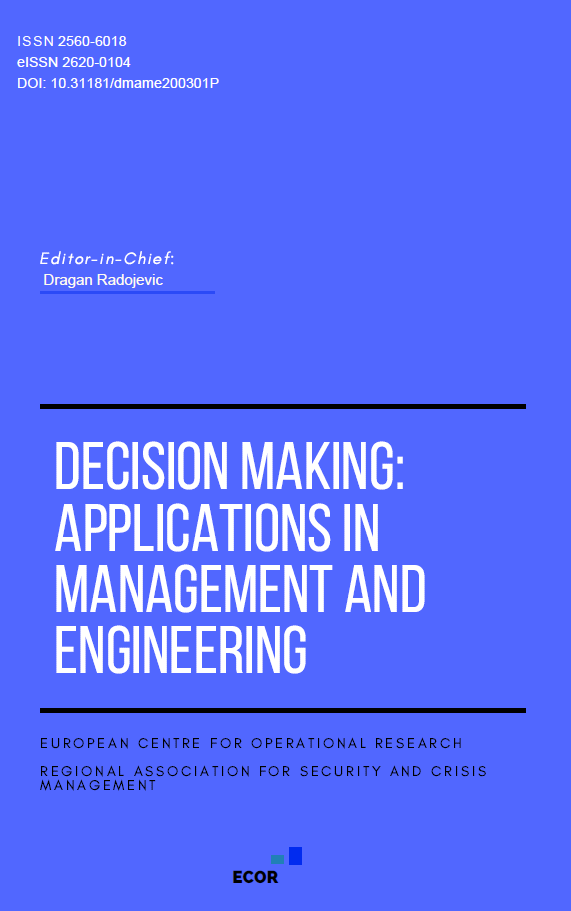Government Subsidies and Patent Race Strategies: A BI-Objective Portfolio Optimization Model for Communication Technology Innovation
DOI:
https://doi.org/10.31181/dmame7120241520Keywords:
Patent Race; R&D; Lagging Firm; Communication Technology; Game TheoryAbstract
This study examines the strategic challenges encountered by communication enterprises engaged in government-subsidised patent competitions, where the effective distribution of R&D resources is essential to offset competitive disadvantages. To address this issue, a bi-objective portfolio optimisation model is proposed, aiming to maximise net returns while simultaneously reducing semi-absolute deviation risk, with consideration of substitution costs and policy-driven subsidies. Using MATLAB-based numerical simulations, the analysis demonstrates that firms with weaker competitive positions can improve their performance in patent races by reallocating investments across significant technological areas in line with their varying levels of risk tolerance. The findings further suggest that when firms possess greater autonomy in decision-making, concentrating resources in core self-interest technologies enhances their chances of achieving success in patent races. Overall, the research contributes theoretical and practical perspectives on R&D portfolio management within policy-supported incentive frameworks.
Downloads
References
[1] Gumulya, D., Purba, J., Hariandja, E., & Pramono, R. (2022). The emergence of innovation capability during firms’ early stage: Cases from Indonesian creative social enterprise. International Journal of Sustainable Development and Planning, 17(7), 2153-2164. https://doi.org/10.18280/ijsdp.170715
[2] Hadi, D., Sutono, A., Wuryandini, E., & Riyanto, P. (2022). FD, & Sari, IA (2023). Efforts to support economic growth and improve MSMEs’ performance during the pandemic. Opportunities and Challenges in Sustainability, 1(2), 95-104. https://doi.org/10.56578/ocs010202
[3] Kumar, A., Yadav, U. S., Mandal, M., & Yadav, S. K. (2024). Impact of Corporate Innovation, Technological Innovation and ESG on Environmental Performance: Moderation Test of Entrepreneurial Orientation and Technological Innovation as Mediator Using Sobel Test. International Journal of Sustainable Development & Planning, 19(7). https://doi.org/10.18280/ijsdp.190720
[4] Stojanović, A., Mashovic, A., & Kasumović, M. (2024). Position of Southeast European countries in the digitalization of manufacturing processes within SMEs: A comparative analysis using EDAS and entropy weighting methodology. Journal of Organizations, Technology and Entrepreneurship, 2(3), 187-197. https://doi.org/10.56578/jote020305
[5] Imran, M., & Rehman, Z. (2024). Interplay of government support and foreign investment in enhancing R&D in China’s strategic sectors. Journal of Organizations, Technology and Entrepreneurship, 2(1), 1-13. https://doi.org/10.56578/jote020101
[6] Aghion, P., Blundell, R., Griffith, R., Howitt, P. & Prantl, S. (2009). The effects of entry on incumbent innovation and productivity. The Review of Economics and Statistics, 91(1), 20-32. https://doi.org/10.1162/rest.91.1.20
[7] Lou, Z., Yao, S. & Zhang, X. (2022). The optimal patent portfolio of the technology standards alliances in innovation competition. Emerging Markets Finance and Trade, 58(6), 1794-1805. https://doi.org/10.1080/1540496X.2021.1918544
[8] Maran, R. (2022). Improving Micro-, Small and Medium Enterprise’s Access to Start-up Financing in ASEAN Countries. Journal of Research, Innovation and Technologies, 1(2), 121-140. https://www.ceeol.com/search/article-detail?id=1086327
[9] Wang, S., Deng, S., Wang, H., & Lv, J. (2018). Literature review on enterprise's patent strategic application and management in the patent race. Soft Science, 32(5), 59-62. https://doi.org/10.13956/j.ss.1001-8409.2018.05.14
[10] Al-Fazari, H., & Teng, J. (2020). A model of duopolistic patent contest with private provisions of industry collective goods. Journal for Global Business Advancement, 13(1), 70-87. https://doi.org/10.1504/JGBA.2020.109146
[11] Fama, E. F., & French, K. R. (1993). Common risk factors in the returns on stocks and bonds. Journal of financial economics, 33(1), 3-56. https://doi.org/10.1016/0304-405X(93)90023-5
[12] Ren, F. (2022). The use of information communication technology in artificial intelligence. Chang jiang Information Communication, 25(9), 95-97. https://doi.org/10.3969/j.issn.1673-1131.2022.09.033
[13] Gilbert, R. J., & Newbery, D. M. (1982). Preemptive patenting and the persistence of monopoly. The American Economic Review, 514-526. https://www.jstor.org/stable/1831552
[14] Merges, R. (1990). On the complex economics of patent scope. Columbia Law Review, 90(4), 839-916. https://doi.org/10.2307/1122920
[15] Denicolò, V. (2000). Two-stage patent races and patent policy. the RAND Journal of Economics, 31(3), 488-501. https://doi.org/10.2307/2600997
[16] Feng, H., Feng, J. L., & Liu, Z. M. (2002). The study of firm's R&D investment strategy in two-stage patent race. Group Technology & Production Modernization, 19(1), 28-32. https://doi.org/10.3969/j.issn.1006-3269.2002.01.008
[17] Kim, W., & Koo, B. (2012). A Patent System with a Contingent Delegation Fee under Asymmetric Information. The BE Journal of Economic Analysis & Policy, 12(1). https://doi.org/10.1515/1935-1682.2702
[18] Wagner, S. (2008). Business method patents in Europe andtheir strategic Use-Evidence from franking device manufacturers. Economics of Innovation and New Technology, 17(3), 178-194. https://doi.org/10.1080/10438590600984042
[19] Parello, C. P. (2015). Model of corporate intelligence, secrecy, and economic growth. International Journal of Economic Theory, 11(2), 205-229. https://doi.org/10.1111/ijet.12061
[20] Leung, C. M., & Kwok, Y. K. (2012). Patent-investment games under asymmetric information. European Journal of Operational Research, 223(2), 441-451. https://doi.org/10.1016/j.ejor.2012.06.033
[21] Jensen, R. & Showalter, D. (2004). Strategic debt and patent races. International Journal of Industrial Organization, 22(7), 887-915.https://doi.org/10.1016/j.ijindorg.2004.06.001
[22] Yang, Y. P., & Fan, X. X. (2024). The influence of strategic emerging enterprises' innovation capability on venture capital from the perspective of patent signaling. Science & Technology Progress and Policy, 41(4), 100-110. https://doi.org/10.6049/kjjbydc.2022090874
[23] Garleanu, N., Panageas, S., & Yu, J. (2012). Technological growth and asset pricing. The Journal of Finance, 67(4), 1265-1292. https://doi.org/10.1111/j.1540-6261.2012.01747.x
[24] Hsu, P.-H., & Huang, D. (2010). Technology prospects and the cross-section of stock returns. Journal of Empirical Finance, 17(1), 39-53. https://doi.org/10.1016/j.jempfin.2009.08.001
[25] Banerjee, T., & Sengupta, A. (2019). Believe It or Not: Strategic Licensing Makes R&D Alliance Profitable. The BE Journal of Economic Analysis & Policy, 19(4). https://doi.org/10.1515/bejeap-2018-0358
[26] Lee, Y. G., Park, K., Kim, H. J., & Cho, S.-H. (2023). Creating portfolios of firm-specific energy R&D investment under market uncertainty. Energy & Environment, 34(5), 1548-1563. https://doi.org/10.1177/0958305X221092401
[27] Beauchêne, D. (2019). Is ambiguity aversion bad for innovation? Journal of Economic Theory, 183, 1154-1176. https://doi.org/10.1016/j.jet.2019.07.015
[28] Yuan, D. Y. (2013). Research on R&D investment strategies of asymmetric duopoly firms in patent race. Master's Thesis: Hefei University of Technology. https://doi.org/10.7666/d.Y2315522
[29] Li, Y. Q., & Wu, Z. R. (2019). Research on Venture Capital, Industrial Experience and Patent Portfolio Strategy. Science & Technology Progress and Policy, 36(2), 86-95. https://www.kjjb.org/EN/Y2019/V36/I2/86
Downloads
Published
How to Cite
Issue
Section
License
Copyright (c) 2025 Decision Making: Applications in Management and Engineering

This work is licensed under a Creative Commons Attribution 4.0 International License.












